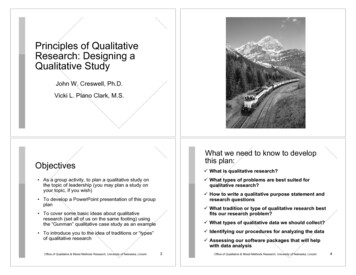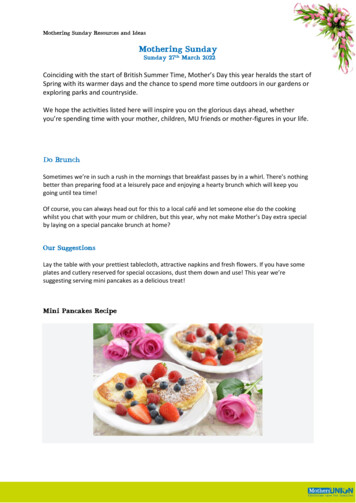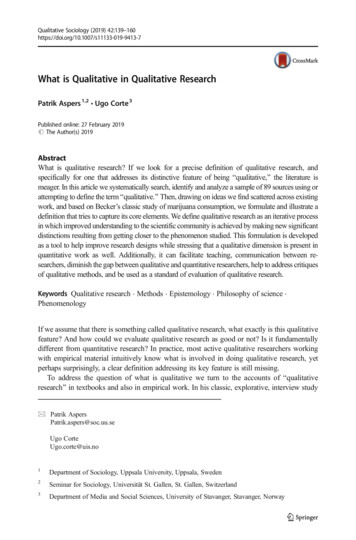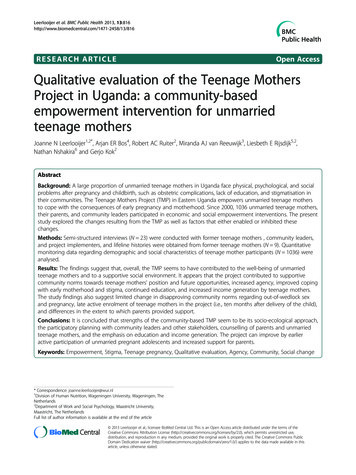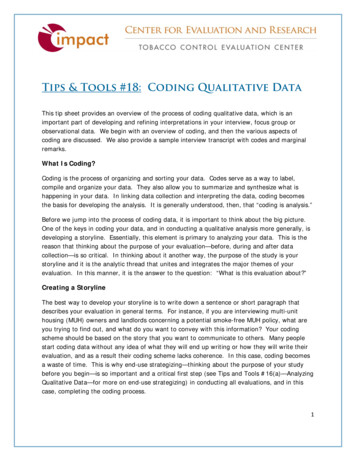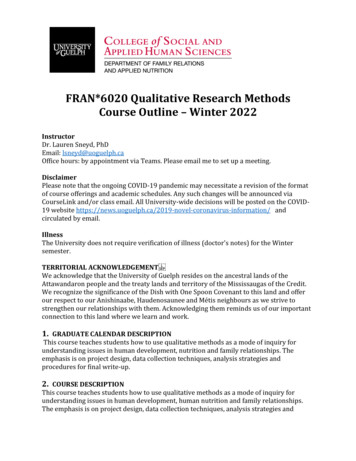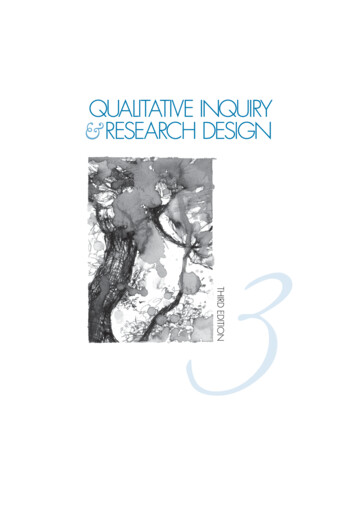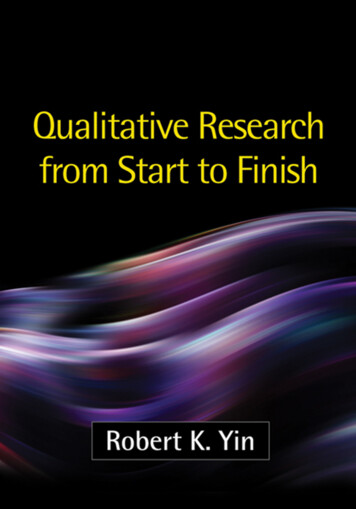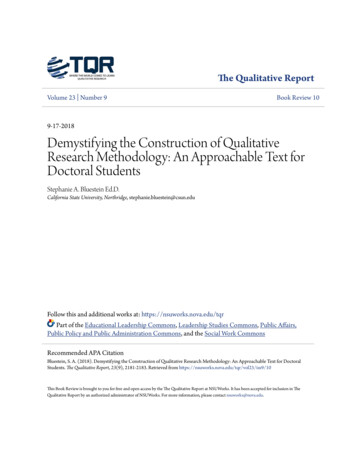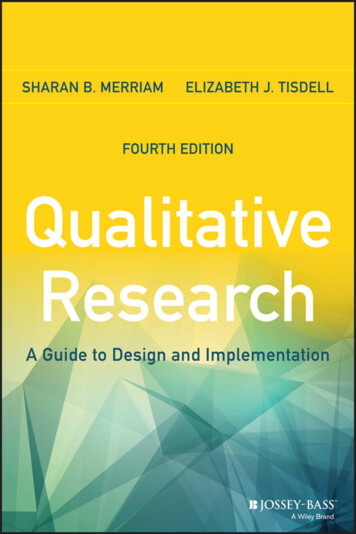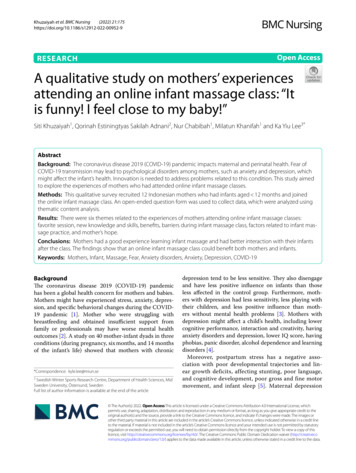
Transcription
(2022) 21:175Khuzaiyah et al. BMC pen AccessRESEARCHA qualitative study on mothers’ experiencesattending an online infant massage class: “Itis funny! I feel close to my baby!”Siti Khuzaiyah1, Qorinah Estiningtyas Sakilah Adnani2, Nur Chabibah1, Milatun Khanifah1 and Ka Yiu Lee3*AbstractBackground: The coronavirus disease 2019 (COVID-19) pandemic impacts maternal and perinatal health. Fear ofCOVID-19 transmission may lead to psychological disorders among mothers, such as anxiety and depression, whichmight affect the infant’s health. Innovation is needed to address problems related to this condition. This study aimedto explore the experiences of mothers who had attended online infant massage classes.Methods: This qualitative survey recruited 12 Indonesian mothers who had infants aged 12 months and joinedthe online infant massage class. An open-ended question form was used to collect data, which were analyzed usingthematic content analysis.Results: There were six themes related to the experiences of mothers attending online infant massage classes:favorite session, new knowledge and skills, benefits, barriers during infant massage class, factors related to infant massage practice, and mother’s hope.Conclusions: Mothers had a good experience learning infant massage and had better interaction with their infantsafter the class. The findings show that an online infant massage class could benefit both mothers and infants.Keywords: Mothers, Infant, Massage, Fear, Anxiety disorders, Anxiety, Depression, COVID-19BackgroundThe coronavirus disease 2019 (COVID-19) pandemichas been a global health concern for mothers and babies.Mothers might have experienced stress, anxiety, depression, and specific behavioral changes during the COVID19 pandemic [1]. Mother who were struggling withbreastfeeding and obtained insufficient support fromfamily or professionals may have worse mental healthoutcomes [2]. A study on 40 mother-infant dyads in threeconditions (during pregnancy, six months, and 14 monthsof the infant’s life) showed that mothers with chronic*Correspondence: kyle.lee@miun.se3Swedish Winter Sports Research Centre, Department of Health Sciences, MidSweden University, Östersund, SwedenFull list of author information is available at the end of the articledepression tend to be less sensitive. They also disengageand have less positive influence on infants than thoseless affected in the control group. Furthermore, mothers with depression had less sensitivity, less playing withtheir children, and less positive influence than mothers without mental health problems [3]. Mothers withdepression might affect a child’s health, including lowercognitive performance, interaction and creativity, havinganxiety disorders and depression, lower IQ score, havingphobias, panic disorder, alcohol dependence and learningdisorders [4].Moreover, postpartum stress has a negative association with poor developmental trajectories and linear growth deficits, affecting stunting, poor language,and cognitive development, poor gross and fine motormovement, and infant sleep [5]. Maternal depression The Author(s) 2022. Open Access This article is licensed under a Creative Commons Attribution 4.0 International License, whichpermits use, sharing, adaptation, distribution and reproduction in any medium or format, as long as you give appropriate credit to theoriginal author(s) and the source, provide a link to the Creative Commons licence, and indicate if changes were made. The images orother third party material in this article are included in the article’s Creative Commons licence, unless indicated otherwise in a credit lineto the material. If material is not included in the article’s Creative Commons licence and your intended use is not permitted by statutoryregulation or exceeds the permitted use, you will need to obtain permission directly from the copyright holder. To view a copy of thislicence, visit http:// creat iveco mmons. org/ licen ses/ by/4. 0/. The Creative Commons Public Domain Dedication waiver (http:// creat iveco mmons. org/ publi cdoma in/ zero/1. 0/) applies to the data made available in this article, unless otherwise stated in a credit line to the data.
Khuzaiyah et al. BMC Nursing(2022) 21:175also increases the risk of children getting cognitive andlanguage difficulties [6]. Mental health-related problems among mothers should be addressed to preventfurther impact and complications such as suicide [7,8], particularly during the COVID-19 pandemic.While discussing maternal mental health, an infant’shealth is also an important issue during the pandemic.When performing infant massage, the mother couldinteract with their infant intensively. They also makeeye contact, skin contact, and meaningful communication through verbal and nonverbal communication.Skin contact can improve the mother-infant attachment and maintain emotional attachment betweenthem [9]. Infant massage might benefit maternalinfant relationships since it combines psychotherapyand education [10]. Some studies indicate that massage improves infants’ development, decreases stressbehavior, positively impacts the immune system andpain tolerance, and accelerates discharge from thehospital [11]. A randomized placebo-controlled trialamong 120 preterm infants shows that natural killercell cytotoxicity was higher in the massage group, particularly among those who received 5 consecutivedays of intervention, than in the control group. Moreover, the weight of infants in the massage group washeavier than those in the control group after the intervention [12]. Infant massage may help relieve colicand stress in the abdomen, increase dopamine levels,and decrease stress hormone level [13] mainly whena mother performs the massage. Daily infant massagefrom parents can improve bonding between infantsand parents, and the parents are more likely to focuson caring for their babies [13]. Infant massage performed by mothers could decrease the depression levelof the mother and provide better interaction [14]. Thisintervention improves the mother–infant relationship and mood state of mothers [15]. Infant massageby mothers therefore significantly reduced the risk ofmaternal postpartum depression (PPD) [16].The International Association of Infant Massage(IAIM) trains and certifies infant massage instructorswho deliver infant massage classes to equip parentswith infant care-related knowledge and massage skills.During the COVID-19 pandemic, the IAIM regulatedthat infant massage classes should be conducted online[17]. However, there is no study evaluating these infantmassage classes to the best of our knowledge. Therefore, this study aimed to explore mothers’ experiencesattending online infant massage classes and improvethe quality of infant massage classes in the future.Page 2 of 8MethodsResearch designThis was a qualitative study exploring the experiences of12 mothers attending an online infant massage class during the COVID-19 pandemic in Indonesia. The ethicalclearance of this study was issued by the Ethics Committee of the University of Muhammadiyah Semarang (no238/KEPK-FKM/UNIMUS/2019), and informed consent was obtained from all participants before conducting this study. The online infant massage class was heldusing Zoom or WhatsApp media. Each participant joinedfour sessions of infant massage class. The period for datacollection was between October 2020 and January 2021.To ensure quality of the research, this study followed32-items of the consolidated criteria for reporting qualitative research checklist [18].Participants and recruitmentThe participants of this study were mothers who hadinfants aged 12 months and had completed four sessionsof infant massage class. Using convenience sampling,participants were recruited based on their availability [19]. Firstly, the researcher reached the participantsby publishing the information about the infant massage class through WhatsApp group and social media.The researchers provided a phone number so motherscould make contact if they intended to participate in thisresearch. A brief description of the study and guidelinesof the online infant massage class were given. If mothersagreed to participate in this study, the researcher askedthem to sign informed consent virtually using a GoogleForm.The online infant massage class was delivered by amidwife who has already been certified as a CIMI (Certified Infant Massage Instructor) by the InternationalAssociation of Infant Massage. The research teamorganized the classes from the Midwifery Department,University of Muhammadiyah Pekajangan Pekalongan,Central Java, Indonesia. There were four sessions forevery class (60 min per session). The duration of theinfant massage class was one month (one session perweek). During the infant massage class, participantscould see each other, both instructor and other participants. The contents of this class were: the concept ofinfant massage, benefits of infant massage, infant cues,oil utilization for infant massage, contraindication ofinfant massage, mother-infant bonding, hand containment, colic abdomen, massage preparation, and infantmassage stroke. During the class, the instructor gavea chance for each mother to practice infant massagestroke, followed by an evaluation of their performance.The participants were asked to express their feelings
Khuzaiyah et al. BMC Nursing(2022) 21:175and experience related to infant massage classes andactivities they performed at home during the period ofinfant massage class.The inclusion criteria of this study were as follows: voluntary participation, mothers with babiesaged 12 months, mothers attending all four sessions of infant massage class, and ability to completean online questionnaire and receive a call. To ensureparticipants included in this study had completed foursessions of infant massage class, we checked the onlineattendance list that we had prepared in advance.Data collection and analysisWe used a qualitative survey asking open-ended questions to allow space for longer narratives and information from respondent [20]. The list of open-endedquestions are presented in Table 1. Utilizing openended questions enables researchers to collect holistic and comprehensive information on the studiedissues [21]. We used a qualitative survey because thismethod allows the researcher to collect data frommore respondents than qualitative interview studies[20]. The survey was delivered using an online platform (Google Form). This method was chosen becausethe survey can be completed by individuals anywhereanytime [22]. Moreover, the online survey was morerational because people were restricted from conducting direct meetings in 2020 due to COVID-19.Page 3 of 8ResultsDemographic characteristicsWe have reached 30 mothers to participate in this study.However, not all mothers could attend online infant massage classes for all sessions (4 sessions per month). Moreover, not all mothers filled out the survey completely.Finally, only 12 mothers met the inclusion criteria andparticipated in this study. The participants were aged24–37 years, and they were primiparous and multiparous. Their infants were aged 1–11 months. All participants were married. Two of them worked in the formalsector, and the rest were unemployed. Four participantsdelivered their infants by cesarean section, while the others delivered their babies by vaginal birth. One of theinfants was delivered prematurely ( 1500 g), while therest were mature (birth weight, 2840–4000 g). Half of theinfants were female. Detailed information about participant characteristics is presented in Table 2.Thematic content analysisSix themes related to the experiences of mothers attending online infant massage class were identified as follow:favorite session, new knowledge and skills, benefits, barriers during infant massage class, factors related to infantmassage practice, and mother’s hope (Table 3).Favorite sessionEight participants stated that they loved the practical session as described below:“I liked when we practice massage stroke from thebeginning until the last” (S, 28 years).“I enjoyed massage technique as each stroke haseach benefit for my baby” (N, 27 years).“I enjoyed the practice of baby massage becauseI can apply the theory I gathered from class” (M,37 years).Data collection and analysisThis study used Colaizzi’s method as it was successfullyused in previous research [23]. The steps included: reading and re-reading each text to gain an in-depth sense ofthe ‘whole’ respondent experiences; putting statementsand phrases which directly pertained to the phenomenain a significant statement; reviewing significant statements; identifying emerging themes; sending back thefindings to participants for validation.Furthermore, two participants enjoyed practicing babymassage in particular areas of the body:“I liked to massage my baby’s foot” (N, 34 years); “ITable 1 Open-ended questions in the qualitative survey Tell me which part you liked the most about the infant massage class? What have you learned about baby massage in this class? Tell us what benefits you get from the infant massage class? How do you feel after taking an infant massage class? Tell me about your feeling when you massage your baby Tell me about the obstacles that mothers experienced during infant massage classes Explain what benefits you get by massaging your infant regularly at home? Tell me what factors make it easier or more difficult for mothers to massage their children at home? Tell me your hopes for your baby in the future
Khuzaiyah et al. BMC Nursing(2022) 21:175Page 4 of 8Table 2 The demographic profile of participants (N 12)Characteristicn (%)Age20–359 (75%) 353 (25%)Educational statusSenior high school2 (17%)Diploma8 (67%)Bachelor1 (0.8%)Master1 (0.8)ParityPara 15 (41.7%)Para 24 (33%)Para 31 (0.8%)More than 32 (17%)Babies Age1 – 6 months7 (58.3%)7–12 months5 (41.7%)Marital statusMarried12 (100%)OccupationNot employed10 (83.4%)Private sector1 (0.8%)Public sector1 (0.8%)Type of birthSpontaneous delivery8 (67%)Section cesarean4 (33%)Gestational age when delivering the babiesPre-mature1 (0.8%)Mature10 (83.4%)Post-mature1(0.8%)Babies’ type of sexualityMale6 (50%)Female6 (50)enjoyed massage baby’s face” (S, 27 years).New knowledge and skillsInfant massage instructors provided knowledge and skillsrelated to infant massage. However, when the motherswere asked about their experiences, they provided different responses regarding their knowledge and skills.Mothers reported that they obtained new knowledgeabout the difference between traditional and modernmassage. They also learned how to care for their infants,massage correctly, and the correct time to massage. Furthermore, mothers learned the infant’s development,massage from foot to head, history, benefits, technique,bonding, oil use, and communication with infants.“I learned many things in this class. For example,I learned how to care for my baby and bounding.”(N, 27 years).“I learned many things such as the technique ofbaby massage and the right time to massage.” (S,27 years).BenefitsBenefits of infant massage classInfant massage class is beneficial for both infants andmothers. Four participants stated that they understood infant massage very well and could practice itindependently.“Now, I understand about baby massage. I couldpractice baby massage independently withoutdepending on dukun bayi (a term that refers toa traditional midwife in Indonesia). Moreover,my child became healthier and more active.” (S,37 years).One of them reported that she was excited to performinfant massage at home and became calmer when performing infant massage:“I became calmer and more excited when performing infant massage.” (N, 34 years).“I gathered new knowledge, and it is beneficial forme as a parent.” (N, 27 years).Moreover, a mother also reported that the infantmassage class was beneficial because she could shareher baby-care-related problems with their peers:“I obtained many benefits from this class. Iobtained new knowledge about baby massage, andI can share the daily problem I faced with others.”(N, 25 years).Infant massage class is also beneficial for mothers tomake a good relationship with their peers attendinginfant massage class. One of the mothers reported thefollowing:“There were lots of benefits I got from infant massageclass. I got new friends, knowledge and I could practice baby massage.” (N, 25 years).As the curriculum of infant massage included discussion sessions about child development and child care,one of the participants reported that they learned aboutthese elements:“I got information about infant massage practice,child development, breastfeeding, and communication.” (S, 37 years).
Khuzaiyah et al. BMC Nursing(2022) 21:175Page 5 of 8Table 3 Themes and subthemes identifiedThemesSubthemes1.Favorite sessionPracticing infant massageMassage technique2. New knowledge and skills they gatheredMassage techniqueInformation about infant massageBonding and caring for babies3. Benefits4. Barriers during infant massage class5. Factors related to infant massage practice6. Mother’s hopeEmotional benefits of infant massage classAll respondents reported the emotional benefit of theinfant massage class. They were happy to join the infantmassage class. The mother’s expressions were as follows:“I am happy! Now I become more independent incaring for my baby.” (S, 28 years).“I am happy because I could practice to my babydirectly.” (N, 27 years).“I am happily joining this class. The tutor deliveredthe material very well, and she demonstrated infantmassage clearly.” (N, 25 years).“Very happy! It expanded my knowledge and triggered me to learn more and become a kind mother.”(M, 37 years).Benefits of infant massage class (Understanding infant massage,obtaining new knowledge, excited to perform infant massage)Emotional benefits of infant massage (happy, grateful)Benefits of practicing infant massage (less fussy infant, comfortable, calm, happy)Poor Internet connectionInfant availability to take part in the classFacilitating factors:The baby has a good mood and free timeHindering factors:The negative mood of babies forgot the strokes and annoying siblingsBabies grow and develop optimallyBabies become active childrenFive respondents reported the benefits related totheir emotions. They were happy and enjoyed performing massage at home:“It’s enjoyable because we can massage the baby atany time in the right way.” (S, 28 years).“I am happy, especially when I massage the baby’sface. When my baby has a toothache, he calmsdown immediately after receiving a massage on hisface (S, 27 years).“My baby was happy when I massaged her.” (K,24 years).“We have to understand the best mood of ourbabies when doing baby massage.” (N, 34 years).“My son has not been able to get a full massagebecause he is very active, but he enjoys every massage I give.” (R, 28 years).Benefits of practicing infant massageMost respondents stated that practicing infant massage was beneficial for them. Mothers mentioned somebenefits of infant massage, including the benefits on theinfant’s sleeping habits, activities, feeding, and motherinfant bonding.“In my experience, babies become less fussy.” (N,27 years).“Thank God! The baby is very comfortable whenmassaged, and the growth is getting better” (M,29 years).“Children feel comfortable, calm, and active, andour bonding is getting better!” (N, 25 years).“After the massage, the baby sleeps calmly, defecatesmoothly, motor movements develop faster.” (E,37 years).Barriers during infant massage classInternet connectionSeven respondents stated that the most significant barrier to joining an online infant massage class was anunstable Internet connection.“The Internet connection was poor. The time wassometimes not effective because it was prior thelunchtime.” (S, 28 years).“Poor signal was the greatest problem because itwas raining so hard.” (N, 27 years).“Signal problem. Babies were fussy, so there was noone to help look after them. The material was difficult to understand.” (D, 32 years).
Khuzaiyah et al. BMC Nursing(2022) 21:175Infant availability to take part in the massage classThe other barrier were infant availability to take part inthe infant massage class.“I could not practice directly on babies because whenthe massage class started, the child was fussy, asleep,etc., if the baby massage class was performed offlineby practicing the baby directly, it seems like would bemore fun, huh .” (K, 24 years).“I was not focused when the baby was fussy anduncomfortable.” (M, 29 years).“When the child was fussy, it became less focused.”(S, 37 years).“The time of the baby massage was the same as thebaby’s bedtime.” (N, 34 years).Factors related to infant massage practiceFactors that helped mothers to perform infant massageeasier were as follows: infant’s good mood and free time.Conversely, factors that made it more difficult were thenegative mood of infants, forgetting the strokes, andannoying siblings.“What makes baby massage easier is when the babycan receive it well and is cooperative, while whatcomplicates the practice of massage is when thebaby does not want to be massaged or is fussy.” (S,28 years).“The thing that makes it easier for me to massagemy baby is because I don’t work so 24 h at home andwhenever possible to massage the baby as long as thetime is right.” (N, 27 years).“It is difficult to massage when the baby is not in themood.” (K, 24 years).“Makes it easier when the baby’s mood is good.”(N,34 years).“Doing baby massage is easier during free time,and the baby is not fussy. It will be more difficult ifthe brothers annoy her and I has troublesome.” (S,37 years).“It’s funny. I feel very close with my baby. Whatmakes it difficult is that brother interferes.” (R,28 years).Mother’s hopeAll respondents hoped that their children grow smoothlyas normal children and are always healthy. They mentioned that, by performing infant massage regularly,they would like their children to develop optimally andbecome active.“I hope that my baby will be healthier in the future,Page 6 of 8not easily sick, grow and develop according to thestages of his age.” (S, 28 years).“Hopefully the development is appropriate and evenfaster. And. he will has better growth. Amen.” (N,27 years).“I hope he becomes a healthy child, grows and develops well and becomes an active child.” (K, 24 years).“I hope my son has more appetite, is more active andsmart.” (D, 32 years).“I hope that children can grow and develop optimally, healthy, strong and intelligent.” (R, 28 years).DiscussionThis study described mothers’ experience after joining online infant massage classes. The main result ofthis study is that there were six themes related to mothers’ experiences attending online infant massage classes:favorite sessions, new knowledge and skills, benefits,barriers during infant massage class, factors related toinfant massage practice, and mother’s hope. This studyis different from previous studies because it exploredthe online infant massage class, whilst others focused onphysical infant massage classes. Generally, the mothers inthis study were happy and equipped with knowledge andskills in infant massage. A previous similar study examined the mother’s experience in attending infant massageclasses in person [24]. This study adds further insights byinvestigating an online infant massage class.Most mothers reported that practicing infant massageis their favorite session. It indicates that practical sessionsare essential for mothers to acquire skills and developbonding with infants. A previous study revealed thatmothers enjoyed infant massage classes and felt closer toinfants [24]. Mothers can make eye contact with infantswhen they conduct the massage. During the process,mothers and infants are together and they have intensive skin to skin contact which could establish a bondbetween a mother and her newborn [25].Furthermore, skin-to-skin contact, breastfeeding, andinfant massage during the first postpartum hour couldpromote bonding between mothers and newborns [26].Eventually, this bonding has lifelong implications for bothmothers and infants. Bonding with a parent or primarycaregiver in the first year would also impact the infant’sdifferent aspects of brain development, including social,emotional, and cognitive development, and lead to happiness, independence, and resilient in adulthood [27].Mothers stated that they learned new skills and knowledge related to infant massage during the online infantmassage class in this study. A previous study indicates anincrease in knowledge and skills after attending the infant
Khuzaiyah et al. BMC Nursing(2022) 21:175massage class [28], of which are beneficial for mothers toperform infant massage independently.Besides acquiring knowledge and skill related to infantmassage, mothers also learned about infant’s daily carethrough peer sharing their own experiences caringfor their infants and supporting each other. While theinstructor provides education about infant massage, shealso has the role of peer support which empowers womento be competent mothers. Peer support, which could beprovided online [29], is a flexible concept used in manyhealthcare fields, including breastfeeding and parenthood [30].After joining the class, most mothers indicated thatthey were happy through a discussion of feelings. Thefindings were consistent with a previous study thatshowed that performing infant massage is a heart-warming, enjoyable, and satisfying moment [31]. In terms ofobstacles in joining online infant massage, the internetconnection appears to be the main issue, as all motherslive in rural areas where they have limited internet access.Spontaneous disconnection from the Zoom meeting distracted both the instructor and participants. The availability and slow-speed internet connection have beenproblematic in online learning [32]. There were also practical issues when conducting the massage class. On someoccasions, infants were sleepy and fussy, and the mothercould not practice massage.The limitation of this study pertains to the data collection conducted through an online platform and telephone call in which the body language of respondentscould not be captured. Body language delivers a nonverbal message which provides further understanding of theexpression of individuals. Despite the limitation of thestudy, the results of this study could be used as a reference to conduct better online infant massage classes inthe future, by preparing a good internet connection andscheduling the right time for babies.Conclusion and recommendationsIndonesian mothers in this study had a good experiencein learning infant massage on an online platform. Nursesand midwives could consider joining the infant massagetraining and encourage mothers to perform infant massage, which is affordable, health-promoting, and safe [24].AbbreviationsCOVID-19: Coronavirus disease 2019; IAIM: The International Association ofInfant Massage.AcknowledgementsThe authors would like to thank Enago (www. enago. com) for the Englishlanguage review. They would also like to thank the LPPM (Research and community service office) Universitas Muhammadiyah Pekajangan Pekalongan fortheir support.Page 7 of 8Authors’ contributionsSK drafted the paper. All authors conceptualized the study, analyzed andinterpreted the data. All authors reviewed and contributed to the intellectualcontent of the paper. All authors read and approved the final manuscript.FundingThis study was funded by the Research and Community Service Office ofUniversitas Muhammadiyah Pekajangan Pekalongan. Open access fundingprovided by Mid Sweden University.Availability of data and materialsThe datasets generated and/or analysed during the current study are notpublicly available due to confidentiality but are available from the corresponding author on reasonable request.DeclarationsEthics approval and consent to participateThe ethical clearance of this study was issued by the Ethics Committee of theUniversity of Muhammadiyah Semarang (no 238/KEPK-FKM/UNIMUS/2019),and informed consent was obtained from all participants. All methods wereperformed in accordance with the relevant guidelines and regulations andadhered to the Declaration of Helsinki.Consent for publicationNot Applicable.Competing interestsThe authors declare that they have no competing interests.Author details1Midwifery Department, Faculty of Health Science, 1st Building of Facultyof Heath Science, Universitas Muhammadiyah Pekajangan Pekalongan,Pekajangan Street No 87, Kedungwuni Pekalongan, Indonesia. 2 Departmentof Public Health, Faculty of Medicine, Universitas Padjadjaran, Bandung,Indonesia. 3 Swedish Winter Sports Research Centre, Department of HealthSciences, Mid Sweden University, Östersund, Sweden.Received: 10 April 2022 Accepted: 21 June 2022References1. Ehsan SM, Jahan F. Analysing the impact of COVID-19 on the mothers ofBangladesh: hearing the unheard. J Public Health. 2021;12:1–4.2. Pacheco F, Sobral M, Guiomar R, de la Torre-Luque A, Caparros-GonzalezRA, Ganho-Ávila A. Breastfeeding during covid-19: A narrative review ofthe psychological impact on mothers. Behav Sci. 2021;11(3):34.3. Dib EP, Padovani F, Perosa GB. Mother-child interaction: implications ofchronic maternal anxiety and depression. Psicol Reflex Crit. 2019;32(1):10.https:// doi. org/ 10. 1186/ s41155- 019- 0123-6.4. Madigan S, Oatley H, Racine N, Fearon R, Schumacher L, Akbari E, CookeJE, Tarabulsy GM. A Meta-Analysis of Maternal Prenatal Depression andAnxiety on Child Socioemotional Development. J Am Acad Child AdolescPsychiatry. 2018;57(9):645-657.e8. https:// doi. org/ 10. 1016/j. jaac. 2018. 06. 012.5. Oyetunji A, Chandra P. Postpartum stress and infant outcome: A reviewof current literature. Psychiatry Res. 2020;284:112769. https:// doi. org/ 10. 1016/j. psych res. 2020. 112769.6. Rogers A, Obst S, Teague SJ,
ing online infant massage class were identied as follow: favorite session, new knowledge and skills, benets, bar-riers during infant massage class, factors related to infant massage practice, and mother's hope (Table 3). Favorite session Eight participants stated that they loved the practical ses-sion as described below:
